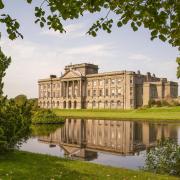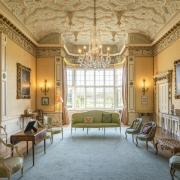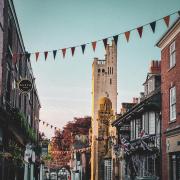Today the village of Alderley Edge is famous for being part of the Golden Triangle of Cheshire, along with Prestbury and Wilmslow, the area noted for its attraction to Premier League footballers, members of the entertainment industry and multi-millionaire business owners.
However, there has been riches here for more than 4,000 years, through the copper was mined from the early Bronze Age until the early 20th century. There is even a mine shaft cut into the sandstone dating back to Roman times in the first century AD. In 1995, members of the Derbyshire Caving Club found a Roman hoard of 564 coins of the Roman Empire dating from 317 to 336 AD.
Many prehistoric tools, including stone hammers used to dig through the sandstone in search of the rich seams of copper ore, have been found throughout the centuries and during the 1870s an oak shovel was unearthed within a shaft. The shovel was carbon-dated to 1750 BC, proving it was of Bronze Age origin. The sandstone edge overlooks vast areas of the Cheshire Plain and in ancient times would have given those who occupied Alderley a distinct advantage, allowing them to observe from a high vantage point any approaching armies or enemies.
Early medieval settlements are also recorded in the area including Nether Alderley, just to the south of the village. The name Alderley features in a charter written in 1280 AD when it was written as ‘Aldredelie’. From the 15th century, the majority of the surrounding estates belonged to the De Trafford baronets. The moated manor house Chorley Old Hall standing to the south of Alderley Edge was built in the 14th century, while the ‘Old Hall’ at Nether Alderley, constructed in the 16th century, burned down in 1779.
The earliest mention of a mill at Nether Alderley comes in the form of a document dated to 1391 AD. It was rebuilt between 1595 to 1597 but the structure we see close to the busy A34 Congleton Road today, which is owned by the National Trust, dates mainly to the 18th century when it was greatly enlarged to boost production.
Both Alderley Edge and Nether Alderley have a rich historical past and today the Alderley History Group exists to carry out further research in the area. The group started up as a result of the Alderley Landscape Project, a 10-year study of Alderley by Manchester Museum and the National Trust. It was founded by the late Harold and Margaret Smith who had a great knowledge of the village’s rich history and its people. The group enjoys talks from knowledgeable historians, archaeologists and other individuals passionate about explaining our past in the surrounding area. The aim of the group is to shed light on the history of the village, to illuminate its present status and include the community of the 21st century, putting it into a historical context for the future. The group hold regular meetings as well as days out to interesting historical places. For more information or to join the group visit alderleyhistory.com or the Facebook page – Alderley History Group.
My film, A Tale of Two Saints, featuring St Mary’s Church Nether Alderley can be viewed by visiting my history channel, youtube.com/@Tvpresenter4history.
LOOK OUT FOR
The copper mines on the escarpment in Alderley Edge
The water mill in Nether Alderley first built in 1391 AD
The church of St Mary, Nether Alderley, dating to the 14th century
LCH October 23 P195 (Columnist> – CHE - James Balme)
Sunrise through the woods looking out from Alderley Edge Adrian Snelius / Getty
Our history man
Alderley Edge
Today the village of Alderley Edge is famous for being part of the Golden Triangle of Cheshire, along with Prestbury and Wilmslow, the area noted for its attraction to Premier League footballers, members of the entertainment industry and multi-millionaire business owners.
However, there has been riches here for more than 4,000 years, through the copper that was mined from the early Bronze Age until the early 20th century. There is even a mine shaft cut into the sandstone dating back to Roman times in the First Century AD and in 1995 members of the Derbyshire Caving Club found a Roman hoard of 564 coins of the Roman Empire dating from 317 to 336 AD.
Many prehistoric tools including stone hammers used to dig through the sandstone in search of the rich seams of copper ore have been found throughout the centuries and during the 1870s an oak shovel was unearthed within a shaft. The shovel was carbon-dated to 1750 BC, proving it was of Bronze Age origin. The sandstone edge overlooks vast areas of the Cheshire Plain and in ancient times would have given those who occupied Alderley a distinct advantage, allowing them to observe from a high vantage point any approaching armies or enemies.
Early medieval settlements are also recorded in the area including Nether Alderley, just to the south of the village. The name Alderley features in a charter written in 1280 AD when it was written as ‘Aldredelie’. From the 15th century, the majority of the surrounding estates belonged to the De Trafford baronets. The moated manor house Chorley Old Hall standing to the south of Alderley Edge was built in the 14th century, while the ‘Old Hall’ at Nether Alderley, constructed in the 16th century, burned down in 1779.
The earliest mention of a mill at Nether Alderley comes in the form of a document dated to 1391 AD. It was rebuilt between 1595 to 1597 but the structure we see close to the busy A34 Congleton Road today, and which is owned by the National Trust, dates mainly back to the 18th century when it was greatly enlarged to boost production.
Both Alderley Edge and Nether Alderley have a rich historical past and today the Alderley History Group exists to carry out further research in the area. The group was founded as a result of the Alderley Landscape Project, a ten-year study of Alderley by Manchester Museum and the National Trust. The group was founded by the late Harold and Margaret Smith who had a great knowledge of the village’s rich history and its people. The group enjoys talks from knowledgeable historians, archaeologists and other individuals passionate about explaining our past in the surrounding area. The aim of the group is to shed light on the history of the village and to illuminate its present status and include the community of the 21st century putting it into a historical context for the future. The group hold regular meetings as well as days out to interesting historical places. For more information or to join the group visit www.alderleyhistory.com or visit their facebook page – Alderley History Group.
My film, A Tale of Two Saints featuring St Mary’s Church Nether Alderley can be viewed by simply visiting my history channel, youtube.com/@Tvpresenter4history.
Things to look out for:
The historic Alderley Edge copper mines on the escarpment in Alderley Edge
The water mill in Nether Alderley first built in 1391 AD
The church of St Mary, Nether Alderley, dating to the 14th century
LCH October 23 P195 (Columnist> – CHE - James Balme)
Sunrise through the woods looking out from Alderley Edge Adrian Snelius / Getty
Our history man
Alderley Edge
Today the village of Alderley Edge is famous for being part of the Golden Triangle of Cheshire, along with Prestbury and Wilmslow, the area noted for its attraction to Premier League footballers, members of the entertainment industry and multi-millionaire business owners.
However, there has been riches here for more than 4,000 years, through the copper that was mined from the early Bronze Age until the early 20th century. There is even a mine shaft cut into the sandstone dating back to Roman times in the First Century AD and in 1995 members of the Derbyshire Caving Club found a Roman hoard of 564 coins of the Roman Empire dating from 317 to 336 AD.
Many prehistoric tools including stone hammers used to dig through the sandstone in search of the rich seams of copper ore have been found throughout the centuries and during the 1870s an oak shovel was unearthed within a shaft. The shovel was carbon-dated to 1750 BC, proving it was of Bronze Age origin. The sandstone edge overlooks vast areas of the Cheshire Plain and in ancient times would have given those who occupied Alderley a distinct advantage, allowing them to observe from a high vantage point any approaching armies or enemies.
Early medieval settlements are also recorded in the area including Nether Alderley, just to the south of the village. The name Alderley features in a charter written in 1280 AD when it was written as ‘Aldredelie’. From the 15th century, the majority of the surrounding estates belonged to the De Trafford baronets. The moated manor house Chorley Old Hall standing to the south of Alderley Edge was built in the 14th century, while the ‘Old Hall’ at Nether Alderley, constructed in the 16th century, burned down in 1779.
The earliest mention of a mill at Nether Alderley comes in the form of a document dated to 1391 AD. It was rebuilt between 1595 to 1597 but the structure we see close to the busy A34 Congleton Road today, and which is owned by the National Trust, dates mainly back to the 18th century when it was greatly enlarged to boost production.
Both Alderley Edge and Nether Alderley have a rich historical past and today the Alderley History Group exists to carry out further research in the area. The group was founded as a result of the Alderley Landscape Project, a ten-year study of Alderley by Manchester Museum and the National Trust. The group was founded by the late Harold and Margaret Smith who had a great knowledge of the village’s rich history and its people. The group enjoys talks from knowledgeable historians, archaeologists and other individuals passionate about explaining our past in the surrounding area. The aim of the group is to shed light on the history of the village and to illuminate its present status and include the community of the 21st century putting it into a historical context for the future. The group hold regular meetings as well as days out to interesting historical places. For more information or to join the group visit www.alderleyhistory.com or visit their facebook page – Alderley History Group.
My film, A Tale of Two Saints featuring St Mary’s Church Nether Alderley can be viewed by simply visiting my history channel, youtube.com/@Tvpresenter4history.
Things to look out for:
The historic Alderley Edge copper mines on the escarpment in Alderley Edge
The water mill in Nether Alderley first built in 1391 AD
The church of St Mary, Nether Alderley, dating to the 14th century
Our history man
Alderley Edge
Today the village of Alderley Edge is famous for being part of the Golden Triangle of Cheshire, along with Prestbury and Wilmslow, the area noted for its attraction to Premier League footballers, members of the entertainment industry and multi-millionaire business owners.
However, there has been riches here for more than 4,000 years, through the copper that was mined from the early Bronze Age until the early 20th century. There is even a mine shaft cut into the sandstone dating back to Roman times in the First Century AD and in 1995 members of the Derbyshire Caving Club found a Roman hoard of 564 coins of the Roman Empire dating from 317 to 336 AD.
Many prehistoric tools including stone hammers used to dig through the sandstone in search of the rich seams of copper ore have been found throughout the centuries and during the 1870s an oak shovel was unearthed within a shaft. The shovel was carbon-dated to 1750 BC, proving it was of Bronze Age origin. The sandstone edge overlooks vast areas of the Cheshire Plain and in ancient times would have given those who occupied Alderley a distinct advantage, allowing them to observe from a high vantage point any approaching armies or enemies.
Early medieval settlements are also recorded in the area including Nether Alderley, just to the south of the village. The name Alderley features in a charter written in 1280 AD when it was written as Aldredelie. From the 15th century, the majority of the surrounding estates belonged to the De Trafford baronets. The moated manor house Chorley Old Hall standing to the south of Alderley Edge was built in the 14th century, while the ‘Old Hall’ at Nether Alderley, constructed in the 16th century, burned down in 1779.
The earliest mention of a mill at Nether Alderley comes in the form of a document dated to 1391 AD. It was rebuilt between 1595 to 1597 but the structure we see close to the busy A34 Congleton Road today, and which is owned by the National Trust, dates mainly back to the 18th century when it was greatly enlarged to boost production.
Both Alderley Edge and Nether Alderley have a rich historical past and today the Alderley History Group exists to carry out further research in the area. The group was founded as a result of the Alderley Landscape Project, a ten-year study of Alderley by Manchester Museum and the National Trust. The group was founded by the late Harold and Margaret Smith who had a great knowledge of the village’s rich history and its people. The group enjoys talks from knowledgeable historians, archaeologists and other individuals passionate about explaining our past in the surrounding area. The aim of the group is to shed light on the history of the village and to illuminate its present status and include the community of the 21st century putting it into a historical context for the future. The group hold regular meetings as well as days out to interesting historical places. For more information or to join the group visit alderleyhistory.com or visit their facebook page – Alderley History Group.
My film, A Tale of Two Saints featuring St Mary’s Church Nether Alderley can be viewed by visiting my history channel, youtube.com/@Tvpresenter4history.
LOOK OUT FOR
The historic Alderley Edge copper mines on the escarpment in Alderley Edge
The water mill in Nether Alderley first built in 1391 AD
The church of St Mary, Nether Alderley, dating to the 14th century



























